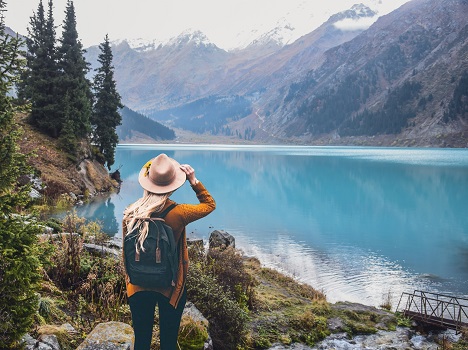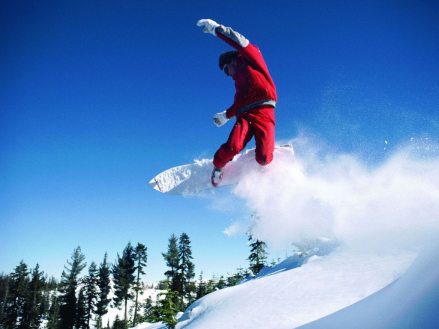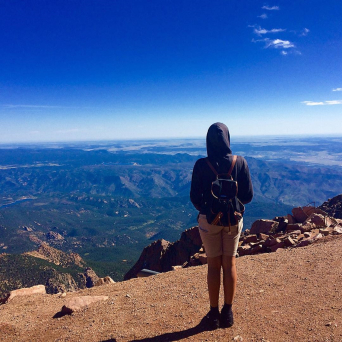- Share
The jewels of Kazakhstan’s nature
All over the world, ecotourism is becoming more and more popular near specially protected natural areas such as national parks and reserves. This is because untouched oases are preserved there, and even if people are allowed any kind of recreation activity, it is quite strictly regulated.
Of course, there are much more places than just these twenty, which we will note in this article. This list will only help those who are traveling for the first time across the country. That is why we would like to list only the brightest pearls of our natural treasures that are located throughout several regions, combining those that are not far from each other into one.
Akmola Province: Burabay and Korgaljyn
Burabay National Park (also known as Borovoe) and the lakes of the Korgaljyn Reserve are certainly the main natural attractions of Akmola Province.
1. The forests and lakes of Burabay are an oasis in the middle of the surrounding steppes. Both northern and southern species of animals such as deer, elk, roe deer, etc, can be found here. In the forests, foxes, wolves and hares are often seen running about. And even if it’s not as often, you definitely will see them at some point! Also there are granite rocks of beautifully bizarre forms, as if they were carved by someone out of giant slabs to resemble these shapes. Almost everyone knows about its legend and their names. It is not surprising that this region has long been loved by both locals and foreign travelers, and a perfect new road directly from Astana (Astana) provides easy access to there. It's just a 2 hour drive, a bit over 250 km, and you are there!

2. To get to the Tengiz-Korgaljyn lake system is more difficult, because the road to there is much worse; but pink flamingos you can see there, makes the treacherous journey worth it! You just need to find the right form of transportation, off roaders in particular. Besides, you are also likely to meet with the steppe Saiga antelopes!

Irgiz-Turgay Nature Reserve in Aktobe Province
3. You can also watch Saigas of the Betpak Dala steppes in Irgiz-Turgay Nature Reserve in Aktobe Province. In particular, Irgiz-Turgay State Nature Reserve was set up to preserve and restore habitats and migration routes of Saiga. Also, the purpose of the reserve is to protect the unique wetlands of Irgiz-Turgay lake system as one of the places of the wetland birds’ highest concentration during seasonal migrations and fish spawning grounds. The lands of the reserve are included in the list of the International Union for Nature protection, as the wetlands is conserving the unique Water fowl and semi aquatic bird species. These far from civilization lands will be of great interest to naturalists.

Almaty Province: from mountain tops to desert dunes.
4. Nearby Almaty, the Big Almaty Lake is one lake you really need to visit, which belongs to the Ile Alatau National Park. There is a paved road, which almost reaches the shore of the lake making it very visited place. Even though sometimes there will be a lack of silence around to fully enjoy the view, do not take the lake off your list. Rare birds such as Sickle Bills still live here as well, and Edelweiss flowers grow on the slopes of the mountains.
5. You can visit several interesting natural sites in the Altyn-Emel National Park. Aktau and Katutau Mountains and the famous “Singing Dune” are just a few of them. There are two sandy hills between the peaks of Big and Small Kalkan. The southern dune rises up to about 150 meters, the Northern – up to 100. The Park is located in the areas near the desert and mountains. About 80 species of mammals and 260 species of birds live here. Argali, Gazelles and Kulans peacefully coexist with each other in this habitat full of spacious plains and mountain slopes of Altyn-Emel. Moreover, the restoration of an endangered species – Przewalski’s horse has been progressing here well for more than ten years.
6. Turgen Gorge, is a place rich in waterfalls and streams, softwood and mixed forests, Alpine and subalpine meadows. The gorge stretches 44 kilometers deep into Asy Plateau (2560 meters in height). A walk to the waterfalls is very popular among travelers. The walking distance from the main road to the Medvezhiy Waterfall (also known as Bear Waterfall) is about a kilometer, and somewhere on the way, on the opposite slope of the gorge, you can get to see the Skalisti Waterfall. After walking further along the large Turgen River to the end of the waterfalls, you can continue the rest of your journey on four wheels. The asphalt road to Batan village ends when you reach the settlement, but the Asy Plateau would be waiting right ahead! After a long serpentine route there is this most wonderful view of the plateau. A spacious summer pasture ‘jailau’ with nomads’ yurt, stretches out to the East towards the Bartogay Reservoir, for 40 km, and in some places reaches up to 15 km in width. On your way to and from, you can see sheepherders’ yurts. And you can even visit them for a cup of hot aromatic tea.

7. Kolsay Lakes are located in the territory of the Kolsay Kolderi National Park, at a height of 1818, 2252 and 2850 meters above sea level. Kaindy Lake is located 12 km east of Kolsay Lakes and stretches out for 400 meters in length. You can visit the two lower Kolsay Lakes and Kaindy Lake in one weekend trip. Upper Kolsay (the third lake) is located about 4 km further from the second one and 600 m higher, and it requires a lot longer walk and better physique of the climber to accomplish this tedious trek. Kolsay is a great place for hiking, horse riding and mountain biking. Kaindy Lake appeared about a hundred years ago as a result of the collapse of a huge mass of rock that blocked the gorge by placing a natural dam. Dry fir trunks rise above the water surface like men on guard. The lake is surrounded by rocky slopes and steep cliffs on all sides, and you can only drive up to the water from one side.
8. Charyn Canyon is one of the most interesting things about the nature encompassing the Almaty Province. The canyon is composed of sedimentary rocks, which can be dated back to about 12 million years! At sunset the walls of the canyon, made from large deposits of clay become red and shimmer with remarkably beautiful hues. The so-called “Castles Valley” is the most visited place by tourists. Charyn Canyon resembles The Grand Canyon in Texas, Colorado, in North America. Although it is inferior in size, the beauty of the “Castles Valley” is enchanting and unique. It will also be interesting to visit the Temirlik Canyon, where a grove of relic ash is preserved, as well as Uzunbulak Canyon (also known as Moon Canyon) and Kurtogay Canyon.
9. Bayankol River Valley is located at the base of the north most seven-thousander in the world, known as Khan Tengri. It has been long known amongst mountaineers. After all, Khan Tengri is a well-promoted brand. However, people who are not so into the world of professional sports can also find something to do and admire here. Other than mountaineers “Khan” also attracts mountain tourists. Every year, several hundred people make trips of varying difficulties to Terskey Alatau. There is also a unique opportunity to watch wildlife such as deer, ibex and argali in their natural habitat. Some lucky people even manage to get a glimpse of a snow leopard! The length of the Bayankol Gorge is 70 km. The source of the Bayankol River begins with glaciers flowing down from the Saryjaz Ridge. These are large glaciers of the Marble Wall: Bayankol and Western. The Bayankol River separates the Terskey Alatau ridge from the Central Tien Shan. It should be mentioned that there is a real summer pasture Jailau in the valley during the summertime, with many authentic yurts, where guests are always welcome!
10. Burkhan Bulak, the highest waterfall in Central Asia, in the Kora Gorge in the Jetysu Alatau Mountains (also known as Dzungarian), is also an object worth considering for travelers in Almaty Province. The height of all its visible cascades is about 112 meters, but it is not as easy to get there! And today the only way to get there is to go through the “Kapalsky izvoz” by a passable transport. Going down to the gorge and to the Kora River, and climbing it while returning from the pass is breathtaking. And there is only 12 km of dirt road on the bottom of the gorge to the waterfall. If you are lucky enough to become a member of the tour to the waterfall, you will not regret it, and all the discomforts of the treacherous road will later be remembered as an interesting adventure!
East Kazakhstan Province: The wonders of Altai
11. Belukha Mountain, the highest point of the Katun range and the highest point of Siberia, is one of the brightest sights of Kazakh Altai. The double peak has been attracting travelers, scientists, esotericists and mountaineers from all over the world since ancient times. The peaks have the form of irregular pyramids: Western (4435 m) and Eastern (4506 m). Belukha saddle is located right in between them, and stands 4000 meters in height. Russian pioneers gave the name Belukha to the mountain, because of the large snow covered peaks. But Kazakhs call the mountain Muztau, which means “Ice Mountain”. These days, travel companies organise various tours at the bottom of Belukha, such as hiking, horse riding and even helicopter drop-offs.

12. Waterfalls and lakes of Katon-Karagay National Park.
Katon-Karagay National Park is the largest protected area in Kazakhstan. Ecosystems of the region have remained almost pristine due to their remoteness and inaccessibility to humans. The Altai Mountains include a variety of landscapes including swamps, forests, meadows and vast tundra. Kokkol Waterfall, the largest one in the East Kazakhstan, is the heritage of the park; with a height which is more than 50 meters. It is located in a very difficult passage near Belukha Mountain. You can get there either by walking or riding a horse. A tourists' trail near the waterfall is popular among travelers heading to the Berel glacier. Yazevy Waterfall is smaller than Kokkol, but its picturesque rocky shores, covered with soft moss and cranberries, will not leave you indifferent to its majestic beauty. Katon-Karagay has been famous for radon springs since ancient times. There are about 400 lakes in the area! And most of them are small with a minor area of up to one square km. The largest lake, Bukhtarma, is located at the headwaters of the Bukhtarma River at the upper border of the forest. The large Rakhmanov Lake is located very close to it. Three larger lakes - Karakol (Yazevoe), Chernovoe and Maraldy, are located on the Listvyaga Ridge. There are many fishes such as Ide and Graylings in the waters of these lakes.

13. Lake Markakol is another attraction of the East Kazakhstan Province which has long been loved by travelers. The lake is located on the territory of the Markakol Reserve between the Azutau ranges in the South and Kurchum in the North. The area is 455 sq km! Many small rivers and streams feed into the lake, and only the Kaljir River flows out. It is also not easy to get to Markakol; a long distance and lack of good roads make the trip a real adventure to overcome, but one which would be worthwhile! The water in the lake is clean and clear, greenish-blue in color, and very soft. And the transparency is a good 4-7 meters deep. Also Uskuch, an unusual fish of the salmon family, is found here.
14. Taiga places of Western Altai. West Altai Reserve is known far beyond the borders of Kazakhstan due to the stone outliers on the tops of the mountains at the junction of the three main ridges of the region, such as Koksu, Ivanovo and Kholzun. The place is called “Kamennaya Skazka”, which translates to Stone Fairytale. On an area of almost 16 square kilometers near the top of the Skazka (2179 m) granite outliers of bizarre shape rise like guardians, sometimes reaching a height of 35 meters! Many of them have their own names as Bogatyrs, Smotryaschiy, Beseda Startsev and others. Except outliers, highland lakes of Beluba attract a lot of attention with their uniqueness, and Kedrovoe Lake is considered to be the most beautiful of them all. The largest high-altitude swamp, Gulbische (six kilometers in length and two in width), a place of summer habitat for ungulate animals such as a roe deer, maral and elk, is located here in the Western Altai intermontane basin. It is also quite possible to meet the owner of the taiga! So, a photo shoot of the animal world, both birds and animals, is guaranteed to you here. The Black Uba River Valley, at the foot of Lyaminoe Belka, is no less of an interesting place to watch the taiga inhabitants from. There are even viewing decks organized for travelers. You can watch moose, deer and roe deer from a safe distance of 3-4 meters of height.
15. Kiinkerish Tract. Unusual in its beauty, Kiinkerish Tract combines intricate red, white and yellow clay “structures”. From a distance, the bright clay cliffs and rocks of Kiinkerish look like tongues of flame. That’s why these rocks are called “Flaming rocks”. Travelers can still find the bones of ancient vertebrates (rhinos, crocodiles, turtles) here. Present forms of flora and fauna attract the attention of scientists, and that’s why they regularly organize scientific expeditions. A hot climate dominating here with the total lack of water creates a fantastically picturesque and mystical atmosphere.

Karaganda Province: Karkaraly National Park
16. A distinctive feature of Central Kazakhstan’s landscape is the local mountain ranges in the steppe and small-mound areas. Karkaraly National Park is the most famous, popular and accessible place for travelers. The relict pine forests are preserved here, and mountain lakes formed in the crater-like depressions of granite rocks are delighting the eye. Two lakes, Shaytankol and Basseyn, located close by Karkaraly have their own names and legends. More than a dozen other mountain lakes are located in the protected western part of the National Park and are as beautiful as the abovementioned lakes. The inaccessibility of the mountainous area is a good habitat for wild animals here, such as moose, roe deer, foxes, hares, etc. There are even Red Book argali!
Mangystau Province: “Gray-blue land” of Ustyurt and “Valley of the Balls”
17. When going to Ustyurt you should bear in mind that there are very long distances, unpredictable weather conditions and lack of accessibility of drinking water on the road. If you want to go there it should be when the weather is dry, because as soon as it starts to rain, it will be impossible to reach the destination. There are a lot of natural attractions in Mangystau, the two main ones are Bozjyra (also spelled as Boszhira, direct translation from the Kazakh language is “Gray-blue land”), a spectacular outlining mountain range, perfect for photo shoots is located on the outskirts of the Western chink of Ustyurt. “Valley of the Balls” is where you will find huge ball noodles formed millions of years ago at the bottom of the ancient ocean.

Pavlodar Province: Bayanaul Mountain
18. Bayanaul, a mountain forest oasis, hundred kilometers from Ekibastuz, is the main natural attraction of Pavlodar Province in the North East of Kazakhstan. Bizarre cliffs, picturesque freshwater lakes; the largest of which are Sabyndykol, Jasybai, Toraigyr and Byrjankol; mysterious caves and grottoes, and most importantly, the distance from big cities, make this region attractive for ecotourists. In 1985 the Bayanaul National Park was formed here. 50 of the 460 species of plants growing in the Park are relict: including Bayanaul pine and stone currant.
.jpg)
Oasis in the North of Kazakhstan
19. Imantau-Shalkar Resort Area of the North Kazakhstan Province. One of the most interesting and insufficiently known regions is certainly Imantau-Shalkar Resort Area of the North Kazakhstan Province, where you can find beautiful lakes and winter outdoor activities. The region holds the first place by the number of lakes in the country; and the second by the number of forests and the third by the length of roads. Picturesque nature, represented by steep hills with bizarre sculptures of mountains-outliers and hollows of lakes, a combination of forest-steppe vegetation and pine forests, makes the Northern region of Kazakhstan attractive for travelers.
Turkistan Province: Aksu-Jabagly, the oldest reserve of the country
20. Aksu-Jabagly Nature Reserve is one of the oldest in Central Asia. First ornithological tours and tours for botanists, interested in tulips, began to be organized in this reserve and near it. No wonder, Grieg's Tulip is an emblem of the reserve! As for the birds, there are 130 species of birds nesting here, 11 of which are listed in the Red Book. The reserve is located in the Talas Alatau Mountains in the Western Tien Shan. Aksu Canyon occupies the central part of the Reserve with a depth of about 1800 m. You can take a walk or ride a horse there.































